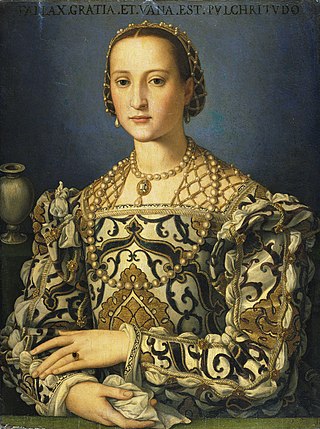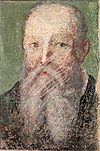
Alessandro di Cristofano di Lorenzo del Bronzino Allori was an Italian painter of the late Mannerist Florentine school.

Cosimo I de' Medici was the second and last duke of Florence from 1537 until 1569, when he became the first grand duke of Tuscany, a title he held until his death.

The Palazzo Vecchio is the town hall of Florence, Italy. It overlooks the Piazza della Signoria, which holds a copy of Michelangelo's David statue, and the gallery of statues in the adjacent Loggia dei Lanzi.

Agnolo di Cosimo, usually known as Bronzino or Agnolo Bronzino, was an Italian Mannerist painter from Florence. His sobriquet, Bronzino, may refer to his relatively dark skin or reddish hair.

Francesco I was the second Grand Duke of Tuscany, ruling from 1574 until his death in 1587. He was a member of the House of Medici.

Eleanor of Toledo was a Spanish noblewoman who became Grand Duchess of Florence as the first wife of Cosimo I de' Medici. A keen businesswoman, she financed many of her husband's political campaigns and important buildings like the Pitti Palace. She ruled as regent of Florence during his frequent absences: Eleanor ruled during Cosimo's military campaigns in Genoa in 1541 and 1543, his illness from 1544 to 1545, and again at times during the war for the conquest of Siena (1551–1554). She founded many Jesuit churches. She is credited with being the first modern first lady or consort.

Justus Sustermans, Joost Sustermans or Suttermans, his given name Italianised to Giusto, was a Flemish painter and draughtsman who is mainly known for his portraits. He also painted history and genre paintings, still lifes and animals.

Francesco Salviati or Francesco de' Rossi was an Italian Mannerist painter who lived and worked in Florence, with periods in Bologna and Venice, ending with a long period in Rome, where he died. He is known by various names, usually the adopted one of Francesco Salviati or Il Salviati, after an early patron, but also Francesco Rossi and Cecchino del Salviati.

Francesco d'Ubertino Verdi, called Bachiacca. He is also known as Francesco Ubertini, il Bacchiacca (1494–1557). He was an Italian painter of the Renaissance whose work is characteristic of the Florentine Mannerist style.

The Portrait of Eleanor of Toledo and Her Son is a painting by the Italian artist Agnolo di Cosimo, known as Bronzino, finished ca. 1545. One of his most famous works, it is housed in the Uffizi Gallery of Florence, Italy and is considered one of the preeminent examples of Mannerist portraiture. The painting depicts Eleanor of Toledo, the wife of Cosimo I de' Medici, Grand Duke of Tuscany, sitting with her hand resting on the shoulder of one of her sons. This gesture, as well as the pomegranate motif on her dress, referred to her role as mother. Eleanor wears a heavily brocaded dress with black arabesques. In this pose, she is depicted as the ideal woman of the Renaissance. The painting is the first known state-commissioned portrait to include the ruler's heir. By including the child, Cosimo wished to imply that his rule would bring stability to the duchy.

Giovanni di Cosimo I de' Medici, also known as Giovanni de' Medici the Younger, was an Italian cardinal.

Lucrezia de' Medici was a member of the House of Medici and by marriage Duchess consort of Ferrara, Modena and Reggio from 1558 to 1561.
The Portrait of Cosimo I de' Medici is a painting by the Italian artist Agnolo di Cosimo, known as Bronzino, finished in 1545. In his position as court painter for the Medici, Bronzino was author of several portraits of Grand Duke Cosimo I de' Medici. In this portrait, Cosimo is represented in his younger years, commanding and proud; and to quote Giorgio Vasari, "clad with white armor and a hand over the helmet". It has been identified as having been painted in the Medicis' Villa of Poggio a Caiano in 1545.

The Deposition of Christ is a painting by the Italian artist Agnolo di Cosimo, known as Bronzino, completed in 1545. It is housed in the Musée des Beaux-Arts de Besançon, France. A copy by Bronzino can be found in the Palazzo Vecchio. This portrayal of the Deposition, although it depicts all the characters typically shown when Jesus is being taken down from the cross, more correctly should be characterized as a Lamentation and is an excellent example of late Mannerism or Maniera.

The Crossing of the Red Sea, also known as The Crossing of the Red Sea and Moses Appointing Joshua, is a fresco painting by the Italian artist Agnolo di Cosimo, known as Bronzino, finished in 1542. It depicts the Israelites crossing the Red Sea from the book of Exodus and Moses commissioning Joshua to lead the Israelites into the Promised Land from the book of Numbers. It is housed in the Palazzo Vecchio, Florence.

Maria de' Medici was the eldest child of Cosimo I de' Medici, Grand Duke of Tuscany and Eleonora di Toledo. She was a member of the famous Medici family.

Maria Salviati was a Florentine noblewoman, the daughter of Lucrezia di Lorenzo de' Medici and Jacopo Salviati. She married Giovanni delle Bande Nere and was the mother of Cosimo I de Medici. Her husband died 30 November 1526, leaving her a widow at the age of 27. Salviati never remarried; after her husband's death she adopted the somber garb of a novice, which is how she is remembered today as numerous late portraits show her attired in black and white.

The Portrait of Bia de' Medici is an oil-tempera on wood painting by Agnolo Bronzino, dating to around 1542 and now in the Uffizi in Florence. For a long time it was displayed in the Tribuna at the heart of the museum, but since 2012 it has been moved to the "sale rosse" of the Nuovi Uffizi. A second portrait, by Pontormo, has also been argued to show Bia de' Medici, but this identification is disputed.

Portrait of Cosimo the Elder is an oil on panel painting by Pontormo, executed c. 1519–1520, now in the Uffizi, Florence.

Portrait of the Dwarf Nano Morgante is a 1552 double-sided painting offering front and back views on either side of the canvas by Bronzino of Nano Morgante the famed court dwarf of Cosimo I de' Medici, Grand Duke of Tuscany who is also immortalized in Valerio Cioli's Fontana del Bacchino at the Boboli Gardens in Florence. The work was commissioned from Bronzino by Cosimo. It portrays Morgante on both sides as a bird-catcher, as he was not permitted to hunt bigger game, this being a pursuit reserved for persons of greater echelon. Morgante is depicted respectively from the front and back at two subsequent moments of the action: at the front he is depicted before the hunt, holding an owl in a snare to be used as a bait to capture a jay that is flying in the air. A duo of rare swallowtail butterflies cover his genitals; these were discovered recently, when the painting was last restored. From behind, he is seen just about to turn towards the viewer with a weapon in his left hand and his quarry in his right, anxious to visually boast of his take.



















